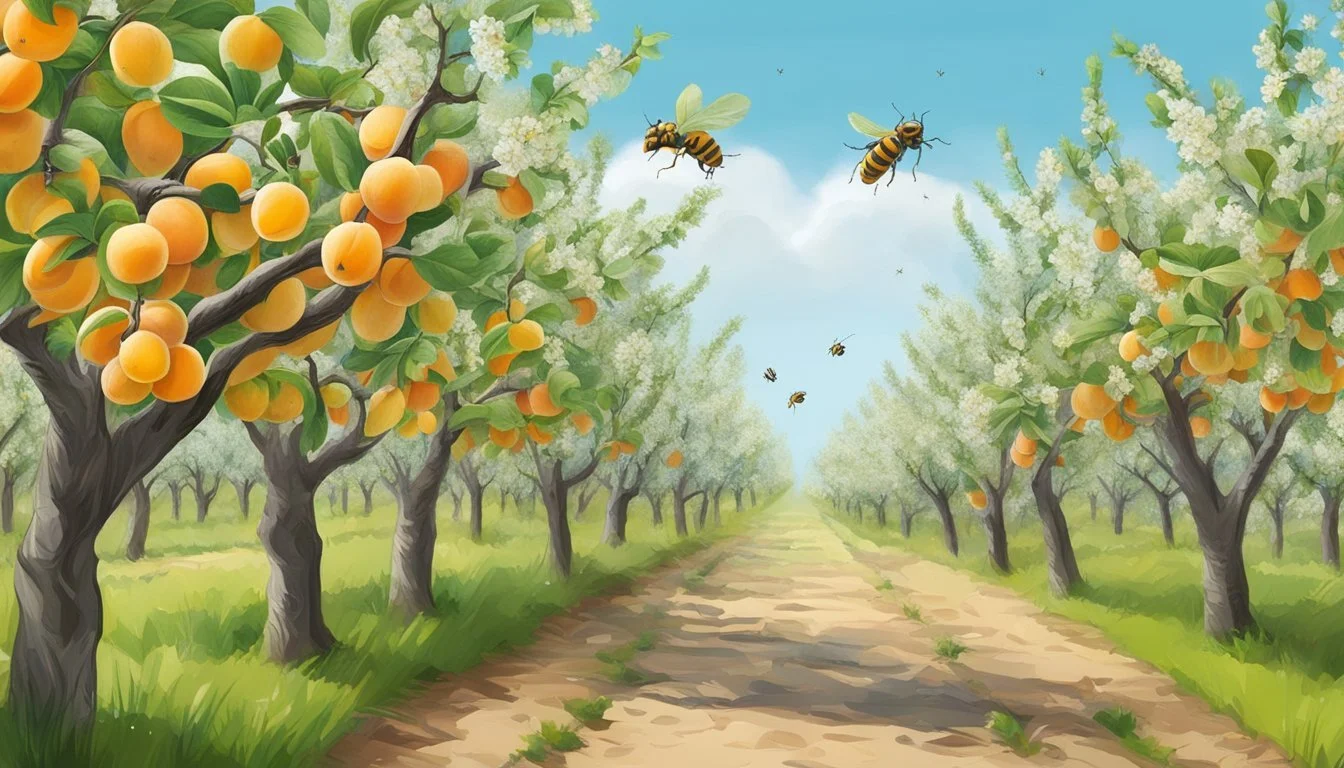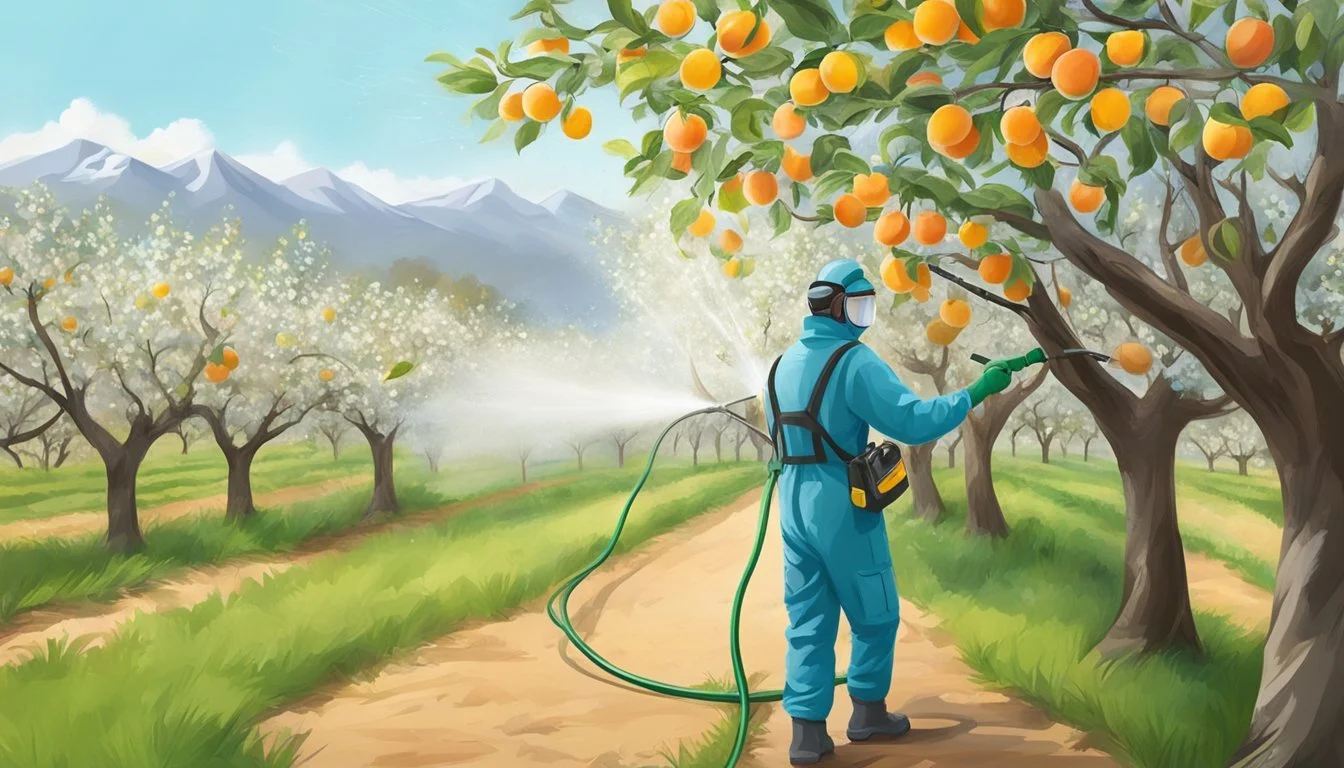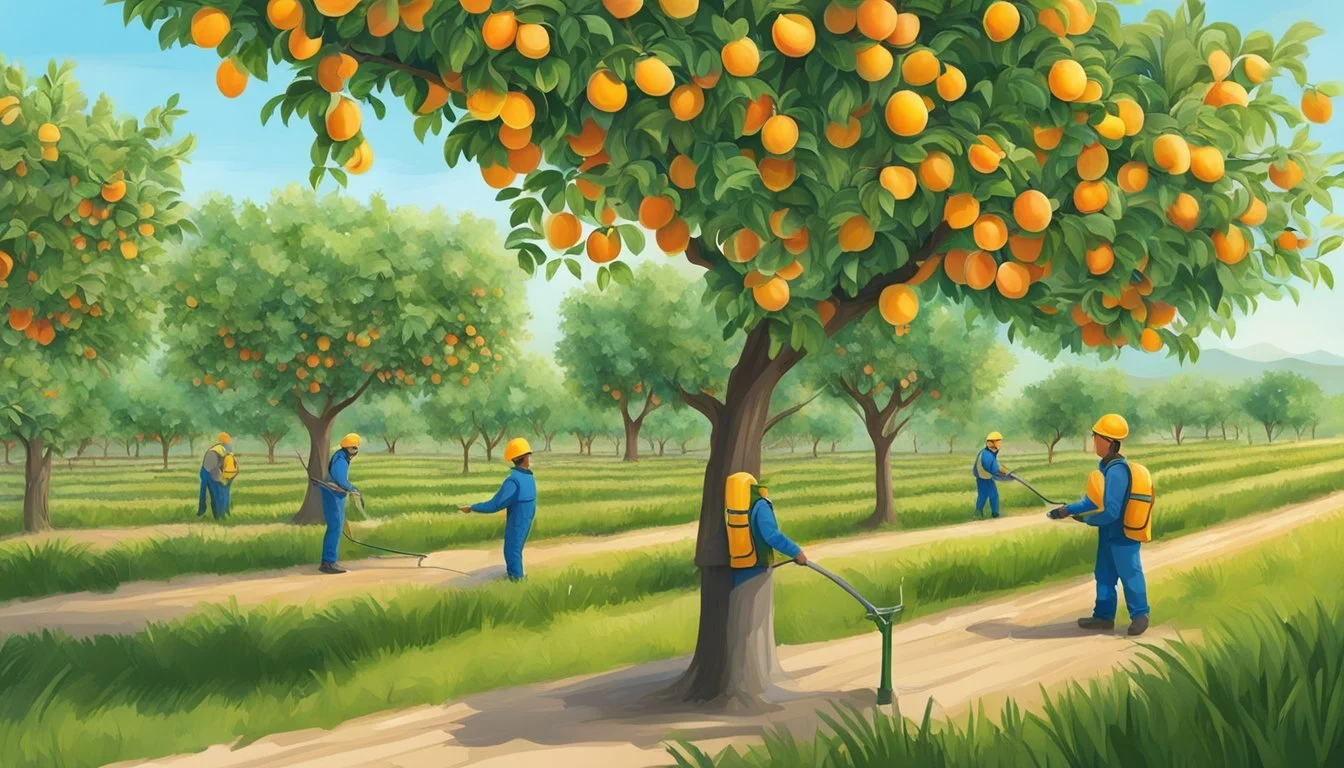Pest Control for Apricot Orchards
Effective Strategies for Growers
Apricot orchards are renowned for their delicate blossoms and succulent fruits, making them a valuable crop for many growers. However, like all agricultural endeavors, they come with their unique set of challenges, one of the most significant being pests and diseases. Effective pest control in apricot trees is crucial for ensuring the health of the tree and the quality of the fruit. It is a meticulous process that requires an understanding of common pests and their behaviors, as well as a strategic approach to management that balances effectiveness with environmental considerations.
Maintaining the health of apricot trees often involves preventative measures, such as choosing disease-resistant varieties and implementing routine maintenance routines. These practices are aimed at keeping problems to a minimum. When infestations do occur, identifying the pest is the first step. Apricot growers must then decide on the most appropriate interventions, which can range from biological controls to chemical applications, the latter being used as sparingly as possible to minimize impact on the ecosystem.
An orchard's pest management plan is often shaped by the specific pests it faces, which can include sap-feeding insects and a variety of fungal diseases. The timing of control measures is critical, as early detection and treatment can prevent the spread of pests and minimize damage. Integrating various methods, such as orchard sanitation to remove disease sources and the application of dormant oil sprays during the non-bearing years, can create a robust defense against a spectrum of potential threats.
Apricot Orchard Site Selection
Selecting the ideal site for an apricot orchard is crucial, as it influences tree health, fruit quality, and economic returns. A well-chosen location addresses climate compatibility, soil health, and effective orchard floor management to mitigate pest pressures and ensure tree vigor.
Climate and Temperature Requirements
Apricot trees thrive in regions with full sun exposure and well-defined seasons. They need a chilling period of 600 to 900 hours below 45°F to break dormancy and initiate spring growth. Areas with late winter frosts should be avoided, as they can damage bloom and reduce yield.
Soil Conditions and Cultivation
Good soil drainage is paramount for apricot orchards to prevent root diseases, with an optimal soil pH between 6.0 and 7.5. Before planting, soil should be tested and amended if necessary. Regular cultivation practices are essential to prepare the ground for establishing a healthy orchard.
Location and Air Circulation
Proper air circulation prevents frost pockets and minimizes disease risk. Apricot orchards should not be situated in low-lying areas. Instead, select elevated or sloped sites to facilitate cold air movement away from the trees, thus reducing the potential for frost damage.
Implementing Orchard Floor Management
Effective weed management in apricot orchards is crucial. Options include organic mulches, like compost and straw, which also conserve soil moisture. In-row mulches can suppress weeds and thereby reduce competition for nutrients and water.
Cost Considerations of Starting an Orchard
The initial costs of establishing an apricot orchard include land, tree stock, and irrigation systems. Other expenses encompass integrated weed management methods and factors such as fencing or netting for pest control. Future growers should prepare for a substantial initial investment before the orchard becomes productive.
Apricot Tree Planting and Care
Proper planting and care are critical for the health and productivity of apricot trees. This includes selecting resistant cultivars, employing effective cultural practices, using organic materials to enrich the soil, and managing water efficiently.
Choosing the Right Cultivars
It is essential to select disease-resistant apricot cultivars that are well-suited to the local climate and soil conditions. Some cultivars offer resistance to common pathogens, which can minimize the need for chemical interventions later on.
Cultural Practices for Healthy Growth
Cultural practices such as pruning play a significant role in maintaining the health of apricot trees. Pruning ensures adequate light penetration and air circulation within the canopy, which can reduce the prevalence of fungal diseases.
Mulching and Organic Matter
Using organic mulches such as compost or hay around apricot trees helps in retaining soil moisture, suppressing weeds, and gradually improving soil fertility as they decompose. Organic matter encourages a healthy ecosystem of beneficial organisms in the soil.
Managing Water and Irrigation
Efficient water management is vital for apricot trees, particularly due to their shallow root systems. Drip irrigation systems can provide consistent moisture while conserving water and reducing the spread of waterborne pathogens.
Pest Management Strategies
Effective pest management in apricot orchards is crucial for maintaining healthy trees and ensuring high-quality fruit production. This section outlines various strategies orchardists can adopt to control and prevent pest damage.
Monitoring Pest Populations
Regular monitoring of pest populations is essential to establish the presence and intensity of pests, mites, aphids, and scale insects. Orchardists typically use traps and visual inspections to track pest levels. Identifying pests early can significantly improve the effectiveness of management strategies.
Biological Control Methods
Biological control involves using natural enemies like predatory mites or organisms such as Bacillus thuringiensis to manage harmful pest populations. Releasing these beneficial organisms into the orchard can suppress the spread of apricot tree pests without harming the trees or the environment.
Chemical Control with Pesticides
Pesticides, including insecticides such as spinosad and sulfur, are utilized to control high infestations of pests. Synthetic pesticides can be effective, but their use should be carefully managed to prevent resistance and minimize impact on non-target organisms.
Organic Alternatives to Chemicals
For those seeking organic pest control options, products like neem oil, insecticidal soap, and Bacillus thuringiensis provide safer alternatives to traditional synthetic chemicals. These options aim to target specific fruit pests with minimal environmental impact.
Physical Pest Control Techniques
Physical methods, such as hand hoeing, mowing, and cross discing, help manage weed pressure and habitat for pests. Orchardists sometimes employ physical barriers to prevent borers and other pests from reaching the apricot trees.
Cultural Control Practices
Cultural practices are key in pest management and include the use of cover crops, proper orchard sanitation, and the management of irrigation and nutrition to improve tree health and reduce pest problems. These practices often support a more sustainable, long-term approach to orchard health.
Integrated Pest Management (IPM)
Integrated Pest Management (IPM) is a comprehensive approach that combines different pest control methods to minimize pest damage effectively and sustainably. IPM strategies include monitoring, biological controls, cultural practices, and the judicious use of pesticides for managing a variety of apricot tree pests.
Disease Identification and Prevention
Effective pest control in apricot orchards starts with recognizing diseases and implementing strategic prevention methods. This section covers identification, prevention, and both organic and synthetic treatment options, along with beneficial cultural practices.
Common Apricot Tree Diseases
Apricot trees are susceptible to several fungal diseases such as brown rot, coryneum blight (also known as shothole), and bacterial canker. Brown rot manifests as soft, brown spots on fruit which can lead to mummified fruit on the branches. Coryneum blight appears as reddish spots on leaves and holes as the tissue falls out. Bacterial canker causes dark, sunken cankers on branches and gummosis, the oozing of sap from the bark.
Preventative Measures Against Diseases
To prevent the incidence of diseases, orchardists must be proactive. Regular monitoring is critical to detect the early signs of scab or cherry leaf spot, a relative condition in apricots. The use of fungicides, such as Monterey Complete Disease Control, can be an effective preventive approach against these fungal afflictions.
Organic and Synthetic Fungicide Options
There are both organic and synthetic fungicide options for apricot disease management. Organic treatments might include copper-based fungicides or biological controls like Serenade Garden Disease Control. For more persistent issues, synthetic fungicides may be required.
Cultural Practices to Mitigate Disease
Incorporating cultural practices is essential in managing apricot diseases. Ensuring proper spacing between trees for airflow, removing any mummified fruit or diseased limbs, and sterilizing pruning tools to prevent the spread of cankers and gummosis are key steps. Additionally, watering in the morning to reduce overnight humidity can diminish fungal growth potential.
Weed and Orchard Floor Management
Weed and orchard floor management are critical components in the cultivation of apricots, influencing both the health of the trees and the quality of the fruit. Effective strategies include a combination of chemical controls, mechanical removal, and the use of organic materials, customized to target specific weed species such as nutsedge, bermudagrass, johnsongrass, and perennial weeds like field bindweed and hairy fleabane.
Preemergence and Postemergence Weed Control
In the fight against weed proliferation, using both preemergence and postemergence herbicides can be highly effective. Preemergence herbicides prevent the germination of weed seeds by creating a barrier in the soil, however, they must be applied before weed species like nutsedge and bermudagrass begin to grow. In contrast, postemergence herbicides are used after weeds have emerged but are most effective before they reach maturity. The careful timing and selection of these herbicides are essential to prevent damage to apricot trees and ensure the weed management process is efficient.
Cultivation and Mechanical Weed Removal
Cultivation and mechanical weed removal are physical methods of weed control that can reduce weed populations and prevent the establishment of hardy species like johnsongrass. Tillage equipment can disrupt the soil and remove existing weeds, but repeated use may lead to soil compaction or erosion. Precision in cultivation practices ensures the safe elimination of weeds without harming the apricot trees' root systems.
Managing Resident Vegetation
Resident vegetation plays a crucial role in orchard health, providing habitat for beneficial organisms and potentially outcompeting unwanted weed species. Management strategies may involve mowing or carefully timed grazing, ensuring that the resident vegetation supports the orchard ecosystem without competing with the apricot trees for resources.
Organic Mulching and Ground Cover
Employing organic mulching and ground cover strategies can suppress weed growth, conserve soil moisture, and improve soil health. Organic mulches, such as straw or wood chips, act as a barrier against weeds and gradually decompose to enrich the soil. Ground covers, either living or synthetic, can also reduce the presence of weeds and minimize the need for herbicides while enhancing the orchard's overall sustainability.
Insect and Mite Control
Effective pest control in apricot orchards involves a targeted approach towards managing various insects and mites that can damage trees and fruit. Using the right techniques for specific pests ensures a healthy orchard with quality apricot production.
Managing Aphids and Mites
Aphids and spider mites pose a significant risk to apricot trees by sucking sap from the leaves, which can lead to reduced tree vigor and fruit quality. Spot treatment with insecticidal soaps or horticultural oils can suppress aphid populations. For spider mites, introducing natural predators such as lacewings can be an ecological approach to control.
Aphids: Use insecticidal soaps or oils.
Spider Mites: Encourage natural predators like lacewings.
Controlling Borers and Moths
Borers, such as the peach twig borer, and moths like the oriental fruit moth can cause significant damage by tunneling into the wood and fruit. Pheromone traps and timely application of insecticides can help in the early detection and management of infestations.
Peach Twig Borer: Monitor with pheromone traps, apply insecticides when active.
Oriental Fruit Moth: Use pheromone traps for detection and timely insecticide application.
Dealing with Beetles and Other Insects
Japanese beetles and earwigs are other pests that can feed on apricot foliage and fruit. Hand-picking or spot treating with insecticides can manage localized infestations of these pests. Flamers can also be used carefully to target Japanese beetle populations.
Japanese Beetles: Hand-picking, spot treatment with insecticides, or careful use of flamers.
Earwigs: Inspection and spot treatment in affected areas.
Alternative Control Methods
Apart from traditional chemical treatments, alternative methods like horticultural oils, biological controls, and mechanical barriers can be effective. Proper orchard hygiene, such as removing debris and mummified fruit that can harbor pests, is essential. The careful application of glyphosate may be necessary, but it should be used judiciously to avoid harm to beneficial organisms and the environment.
Biological Controls: Use of natural predators and parasites for pests.
Mechanical Barriers: Use of traps and barriers to prevent insect infestation.
Orchard Hygiene: Regular cleaning to remove potential pest habitats.
Seasonal Maintenance for High Yield
Effective seasonal maintenance is vital for ensuring a high yield in apricot orchards. Adhering to specific practices can protect apricot trees against frost damage, encourage fruitful growth, and maintain overall tree health.
Spring Frost Protection
To secure a plentiful apricot harvest, spring frost protection is crucial. Apricot trees that blossom early are prone to frost damage, which can significantly reduce yield. Growers may employ strategies such as frost fans or water sprinklers to mitigate the risk during cold snaps. The objective is to keep the delicate blossoms from freezing, thus preserving the potential for fruit set.
Summer Pruning and Thinning
In summer, pruning and thinning are essential to ensure apricot trees yield quality fruit. Pruning apricot trees serves a dual purpose: it allows sunlight to penetrate the canopy for fruit ripening and promotes air circulation to reduce disease incidence. Thinning the fruit is equally important; by removing excess fruit, the remaining apricots can grow to their optimal size and sweetness.
Fall Orchard Cleanup
After harvest, a thorough fall cleanup is key to preparing apricot trees for the next growing season. Removing mummified fruit and fallen leaves from the orchard floor reduces the habitat for pests and diseases. Pruning out dead or diseased wood before winter sets in helps to sustain the health of apricot trees, laying the groundwork for next year's yield.
Supplemental Topics in Apricot Cultivation
This section delves into specialized areas of apricot cultivation, offering a deeper understanding for home orchardists and professionals alike. From intricacies of managing companion plants to the promise of innovative techniques in pest control, growth factors affecting seedlings, and the integration of nut-bearing trees, these supplementary topics are vital for a holistic approach to apricot orchard management.
Managing Stone Fruit Companions
Cultivating stone fruits like peaches, plums, and apricots together can promote biodiversity, but they require specific management practices. Home orchards benefit from companion planting, which can enhance pollination rates and potentially reduce pests due to the diversified ecosystem.
Peaches, for instance, can be strategically planted to provide shelter and alter microclimates beneficial for apricots.
Plums may share similar pest pressures, and compatible management strategies can be synchronized.
Innovative Pest Control for Home Orchardists
For home orchardists, embracing innovative pest control strategies is crucial. Some might opt for physical protection methods like rain shelters, which have shown to significantly reduce twig blight in apricots. Integrating non-chemical approaches such as these can contribute to a more sustainable orchard ecosystem.
Growth and Yield of Apricot Seedlings
The growth and yield of apricot seedlings are influenced by various factors:
Cultivar selection: Different apricot varieties exhibit diverse growth rates and yield potentials.
Rootstock choice: Plays a pivotal role in determining the vigour and adaptability of seedlings.
Careful consideration of these aspects supports robust seedling development essential for future productivity.
Augmentation with Nut-Bearing Trees
Incorporating nut-bearing trees, like pears or walnuts, into apricot orchards can offer multiple advantages:
They provide a year-round canopy structure for varied wildlife.
Nut crops can diversify income streams for growers.
This approach requires thoughtful planning to ensure the nutritional and spatial requirements of all tree species are met, and there's minimal competition for resources.
Chemical Applications and Safety
In managing pests in apricot orchards, it is essential to apply chemicals judiciously while ensuring safety for both the environment and the applicators. Proper understanding and adherence to guidelines are key in this process.
Proper Use of Insecticides and Herbicides
Chemical control in apricot orchards often involves the use of insecticides and herbicides to manage a range of pests and weeds that can affect the health and productivity of the trees. It is crucial to apply products such as acetamiprid and carbaryl according to the manufacturer's instructions, at the recommended rates, and at appropriate times to maximize effectiveness and minimize harm to non-target organisms. For successful weed management, options like integrated weed management highlight the importance of combining chemical applications with other control methods.
Guidelines for Synthetic Chemicals
When utilizing synthetic chemicals such as captan, malathion, and permethrin, growers must follow strict guidelines to prevent the development of pesticide resistance in pest populations. They should rotate chemicals with different modes of action and incorporate a mix of management strategies. For example, according to the Pesticide Application Checklist, one should consider resistance risk when selecting a pesticide and ensure proper calibration of spray equipment to achieve the desired coverage.
Understanding Organic Pesticide Ingredients
Organic orchards require a different approach, using pesticides with organic ingredients like neem oil and pyrethrins, which are derived from natural sources. These products are often favored for their lower environmental impact, but like synthetic products, they must be used correctly to be safe and effective. It is recommended to use organic weed control techniques as part of a broader orchard management strategy to limit reliance on any one type of control method.
Frequently Asked Questions
Effective pest and disease management is crucial for maintaining healthy apricot orchards. The following FAQs provide targeted solutions to common problems faced by apricot growers.
What treatments are effective against shot hole disease in apricot trees?
Fungicidal sprays are typically used to control shot hole disease, especially during the spring before the leaf buds open. Consistent pruning and sanitation can also help reduce the spread of the disease.
How can peachtree borers be controlled in apricot orchards?
Pheromone traps and appropriate insecticides can help manage peachtree borer populations. Applying protective tree wraps during the larvae stage is also a common preventive measure.
What methods are recommended for managing aphid infestations in apricot trees?
Encouraging natural predators, such as lady beetles and lacewings, and using insecticidal soaps or oils can effectively control aphid populations in apricot trees.
Which practices help reduce the incidence of powdery mildew on apricots?
Proper air circulation and sunlight penetration are key in preventing powdery mildew. Fungicides may be necessary for severe cases, but cultural controls should be the first line of defense.
How do you control scale insects on apricot trees?
Dormant oil sprays during the off-season can suffocate scale insects. During the growing season, narrow-range oil or insecticidal soap can be applied to manage infestations.
Are there any disease-resistant varieties of apricot trees to consider planting?
Some apricot tree varieties have been bred for increased resistance to common diseases. These varieties can significantly reduce the dependency on chemical treatments in an orchard.







